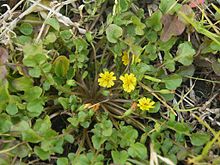
Adenophora is a genus of flowering plants in the family Campanulaceae, the bellflowers. Plants of this genus are known commonly as ladybells. Most are native to eastern Asia, with a few in Europe. Many are endemic to either China or Siberia.

The Beijing–Taipei Expressway, designated as G3 and commonly known as the Jingtai Expressway, is a partially completed Chinese expressway that, if fully constructed, would connect the People's Republic of China with Taiwan. Currently, the expressway is complete from Beijing to Fuzhou, Fujian, and is fully complete in Mainland China except for a small section in Fujian which is under construction.

Osmanthus is a genus of about 30 species of flowering plants in the family Oleaceae. Most of the species are native to eastern Asia with a few species from the Caucasus, New Caledonia, and Sumatra. Osmanthus has been known in China since ancient times with the earliest writings coming from the Warring States period; the book Sea and Mountain. South Mountain states: "Zhaoyao Mountain had a lot of Osmanthus".
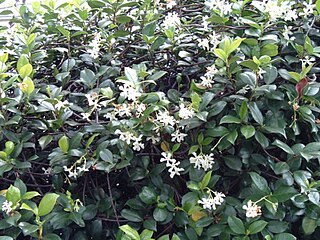
Trachelospermumstar jasmine, Confederate jasmine, is a genus of evergreen woody vines in the dogbane family Apocynaceae, first described as a genus in 1851. All species are native to southern and eastern Asia.

Sun Chuanfang was a Chinese warlord in the Zhili clique and protégé of the "Jade Marshal" Wu Peifu.

Haplogroup O, also known as O-M175, is a human Y-chromosome DNA haplogroup. It is primarily found among populations in Southeast Asia and East Asia. It also is found in various percentages of populations of the Russian Far East, South Asia, Central Asia, Caucasus, Crimea, Ukraine, Iran, Oceania, Madagascar and the Comoros. Haplogroup O is a primary descendant of haplogroup NO-M214.

The Nanjing Military Region was one of the former seven military command regions for the Chinese People's Liberation Army. Its jurisdiction covers all military and armed police located in Anhui, Jiangsu, Zhejiang, Jiangxi, Fujian, and Shanghai. It also covers Taiwan, which is claimed by the People's Republic of China but administered by the Republic of China. The head of the region was Cai Yingting. This region is now part of the Eastern Theater Command.

Cinnamomum tenuifolium, commonly known as Japanese cinnamon, is an evergreen tree in the genus Cinnamomum. It is a small- or medium-sized tree up to 15 m (49 ft) tall that occurs in Japan, Korea, Taiwan, and eastern China. In China it is under second-class national protection.
The Campaign to Suppress Bandits in Eastern China was a counter-guerrilla / counterinsurgency campaign the communists fought against the nationalist guerrilla that was mostly consisted of bandits and nationalist regular troops left behind after the nationalist government withdrew from mainland China. The campaign resulted in communist victory.

Lophatherum is a genus of Asian and Australian plants in the grass family.
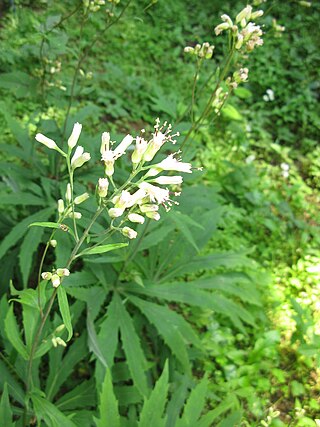
Syneilesis is a genus of East Asian plants in the groundsel tribe within the Asteraceae.

Vitis flexuosa is a species of liana in the grape family.
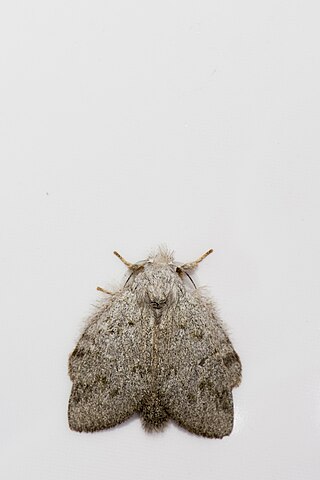
Syntypistis subgeneris is a species of moth of the family Notodontidae first described by Strand in 1915. It is found in China, Taiwan, Japan, Korea, Sikkim and Vietnam.

Dioscorea japonica, known as East Asian mountain yam, yamaimo, or Japanese mountain yam, is a type of yam (Dioscorea) native to Japan, Korea, China, Taiwan, and Assam.
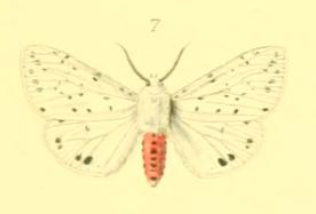
Spilosoma punctaria is a moth in the family Erebidae. It was described by Caspar Stoll in 1782. It is found in the Russian Far East, China, Korea, Taiwan and Japan.

Spilarctia subcarnea is a moth in the family Erebidae. It was described by Francis Walker in 1855. It is found in Nepal, China, the Russian Far East, Korea, Japan and Taiwan.

Sagittaria pygmaea, commonly known as the dwarf arrowhead or pygmy arrowhead, is an aquatic plant species. It is a perennial herb producing by means of stolons. Leaves are linear to slightly spatula-shaped, not lobed, up to 30 centimetres long.
Matsumurella is a genus of flowering plants in the family Lamiaceae, first described in 1915. It is native to China and Japan. The genus is closely related to Galeobdolon, and the species below are discussed under that name in Flora of China.
- Matsumurella chinensis(Benth.) Bendiksby - Anhui, Fujian, Guangdong, Guangxi, Hunan, Jiangsu, Jiangxi, Taiwan, Zhejiang
- Matsumurella kwangtungensis(C.Y.Wu) Bendiksby - Guangdong
- Matsumurella szechuanensis(C.Y.Wu) Bendiksby - Chongqing
- Matsumurella tuberifera(Makino) Makino - Japan, Ryukyu Islands, Taiwan, Guangxi, Hunan, Jiangxi
- Matsumurella yangsoensis(Y.Z.Sun) Bendiksby - Guangxi

Mosla is a genus of plants in the family Lamiaceae, first described as a genus in 1875. It is native to eastern Asia, the Himalayas, and southeastern Asia.
- Mosla bracteataDoan ex Suddee & A.J.Paton - Vietnam
- Mosla cavalerieiH.Lév.- Vietnam, Guangdong, Guangxi, Guizhou, Hubei, Jiangxi, Sichuan, Yunnan, Zhejiang
- Mosla chinensisMaxim. - Vietnam, Korea, Japan, Anhui, Fujian, Guangdong, Guangxi, Guizhou, Hubei, Hunan, Jiangsu, Jiangxi, Shandong, Sichuan, Taiwan, Zhejiang
- Mosla coreanaH.Lév. - Korea
- Mosla dianthera(Buch.-Ham. ex Roxb.) Maxim. - China, Japan, Korea, Ryukyu Islands, Kuril Islands, Primorye, Caucasus, Himalayas, Myanmar, Vietnam, Philippines, Sumatra
- Mosla exfoliata(C.Y.Wu) C.Y.Wu & H.W.Li - Sichuan
- Mosla hangchouensisMatsuda - Zhejiang
- Mosla japonica(Benth. ex Oliv.) Maxim. - Japan, Korea, Ryukyu Islands
- Mosla longibracteata(C.Y.Wu & S.J.Hsuan) C.Y.Wu & H.W.Li - Guangxi, Zhejiang
- Mosla longispica(C.Y.Wu) C.Y.Wu & H.W.Li - Jiangxi
- Mosla pauciflora(C.Y.Wu) C.Y.Wu & H.W.Li - Guizhou, Hubei, Sichuan
- Mosla punctulataNakai - Korea, Taiwan, Japan, China
- Mosla scabra(Thunb.) C.Y.Wu & H.W.Li - Vietnam, Korea, Japan, Ryukyu Islands, Anhui, Fujian, Gansu, Guangdong, Guangxi, Henan, Hubei, Hunan, Jiangsu, Jiangxi, Liaoning, Shaanxi, Sichuan, Taiwan, Zhejiang
- Mosla soochouensisMatsuda - Anhui, Jiangsu, Jiangxi, Zhejiang
- Mosla tamdaoensisPhuong - Vietnam

Glochidion puberum is a species of shrub or small tree in the family Phyllanthaceae. It is native to China, where it is widely distributed in both subtropical and temperate regions. It has also been reported from Taiwan and Japan, and is morphologically very similar to the species Glochidion chodoense, endemic to southern South Korea. In Mandarin it is known as 算盘子 (suanpanzi), which also refers to the genus Glochidion as a whole. In China it is used for medicinal purposes.
